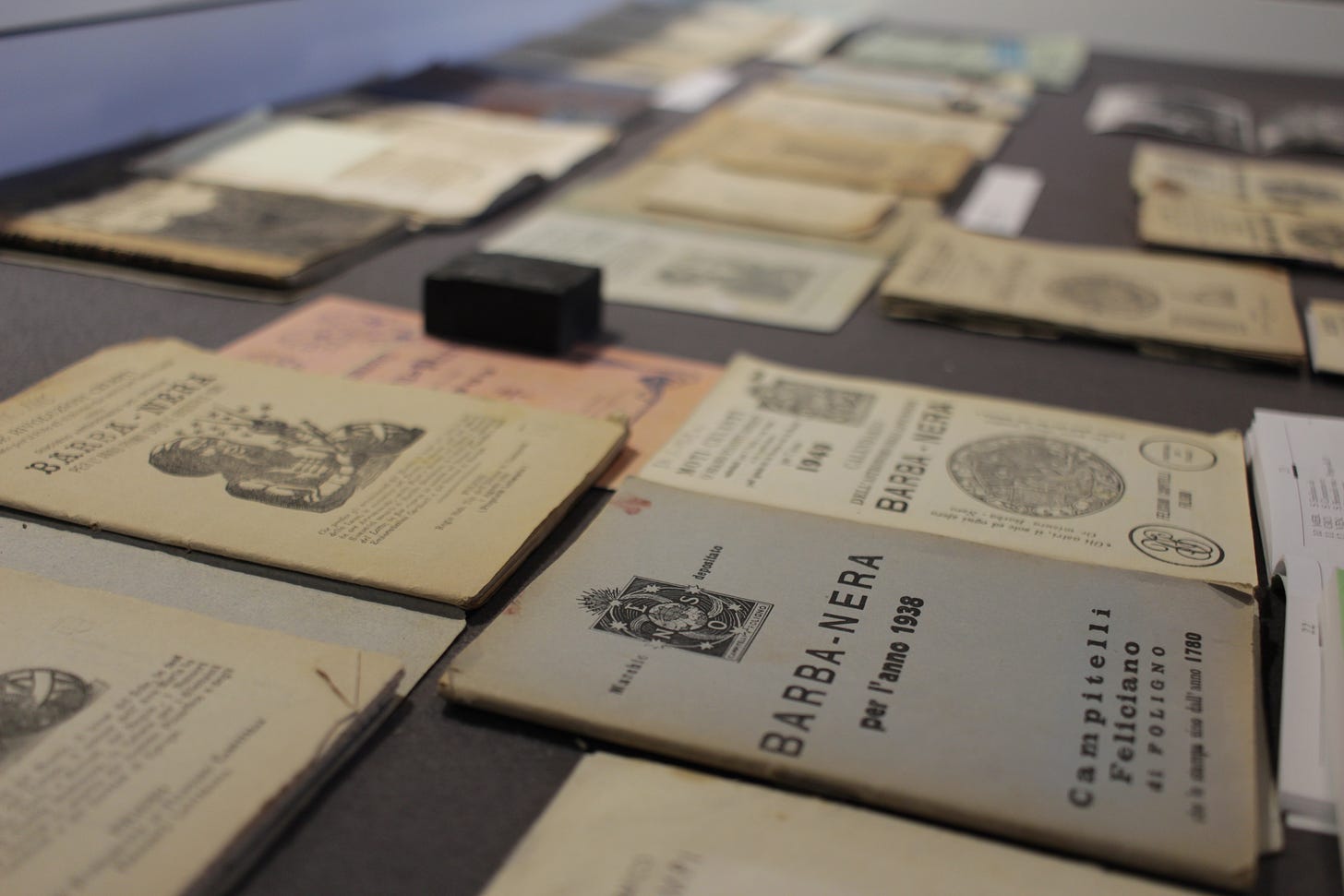Ómós Digest #184: La Barbanera
Italy’s guide to reconnecting with nature. Written by Hugo McCafferty.
Dear Readers,
I was fascinated to learn about the orto; the humble vegetable gardens distributed throughout Italy, etched into every possible inch of land where a seed can grow. Food in Italy is not a lifestyle trend or a domestic chore – it is a way of being. At the heart of this culture, both guiding and reflecting it, is the centuries-old Barbanera almanac: part farmer’s companion, part philosopher’s guide, part cultural artifact. In exploring its legacy, we gain not only an insight into Italy’s past but perhaps a vision of our collective future.
As a side note, today is the last newsletter of the month. I wasn’t sure whether I should share this piece of personal news, but I am getting married this week (by the time you read this, I’ll be married), and so I feel it's time for a break. I’m actually going to be traveling to Puglia and Rome, where I hope to come across some Italian ortos. I hope you understand and I look forward to coming back in June for what will be a very exciting year ahead.
Finally, thank you all for your incredible support so far and, as always, for making this newsletter possible. We hit 5,000 subscribers last week, and I personally believe that the newsletter has never been stronger. Most of that is down to the amazingly talented and diverse writers we now have contributing every month. I’m learning from each of them every week, and none more so than in this wonderful newsletter from Hugo.
When I first moved to Italy, nearly twenty years ago, one of the things that struck me was the culture of the ‘orto’ – the vegetable gardens that were visible everywhere. Not only do most private gardens have a dedicated section to growing food, but you notice them scattered throughout the landscape. Derelict plots and even thin pieces of land along train tracks are claimed by ‘guerilla’ gardeners (usually retired ‘nonni’ to whom unutilised land is a front to their compulsion to cultivate). This is still a land of farmers. Of all the developed Western countries, Italy stands as an example of a culture that holds food at the centre of everyday life – and not just around the dinner table. Food is key to every aspect of Italian living; it permeates and touches everything, from language to art to identity and purpose. For all of the country’s wealth of cultural riches, it is this part of living in Italy that is the most beautiful and inspiring.
We are all familiar with the stereotypes of Italians taking offense to broken spaghetti or pineapple on pizza, but there is good reason for their protective attitude. Food is sacred to the Italians and to insult their cuisine is to strike at their very soul. And what is food, but the full expression of the relationship between humans and nature, between man and the land? You can see this everywhere. Despite aggressive post-war industrialisation, especially in the north, and the mass-migration of peasant workers from rural areas to industrial urban centres, the Italians have endeavoured to preserve that relationship. Anyone can apply to their local town hall for an allotment; a plot of land that is cultivated in groups, to pool resources, knowledge, and build community. From the biggest cities to the remote wilderness, and anywhere in between, every space, every terrace becomes more than a garden, but a place to grow tomatoes, greens, roots, fruit, and berries. They have managed to maintain that direct connection with the land through food, from the orto to the kitchen. The grandfather’s produce, the grandmother’s love and care in the kitchen – these are the fundamentals of Italian cuisine. It is an ancient tradition that has endured the millennia, through various colonial invasions, wars, massive industrialisation, modernisation and emigration.
A companion to this tradition – and one that has in some way contributed to it – is ‘La Barbanera’ almanac. For over two hundred years, it has been an ever-present guide, helping Italians to arrange their lives around the cycles of nature, the seasons, and the movement of heavenly bodies. In many Western cultures, ‘almanac’ can be viewed in a derogatory sense. Modernity casts a withering look on the superstition of tradition, but the Barbanera in Italy is different. It is loved, treasured, and respected, much as the elderly are cherished in Italian society. You may not agree with all of its content, you may not fully understand it, but you respect it.
The almanac is published at the beginning of the year and contains a daily calendar of advice, from when to sow, cut, prune and harvest. It also contains snippets of ancient wisdom and proverbs; prompts to think about the world in a certain way. You’ll even find advice on traditional remedies and the herbalist’s guide to using your garden in promoting health and wellbeing. The earliest known edition was printed in 1762 by Pompeo Campana in Foligno. This initial publication featured a calendar and predictions attributed to the legendary figure Barbanera, depicted with a long black beard. The almanac became hugely popular all over the Italian peninsula. Despite every region having its own almanac, the Barbanera became a cultural unifier, more than a century before the inception of an Italian nation. Key to its success was the accessibility of information contained in it, delivered in the printed word with clever symbology, allowing the almanac to be used by the illiterate.
Through the centuries, La Barbanera has been lauded by various notable figures in Italy. Gabriele D’Annunzio (1863–1938), the renowned poet and writer, praised the Barbanera almanac, referring to it as “the flower of all time and the wisdom of nations". The famed Italian semiologist and writer, Umberto Eco, in his 2012 column in L’Espresso magazine, wrote about the Barbanera: “The advice in the Foligno almanac makes you feel in harmony with nature,” which perhaps most succinctly describes the appeal of the publication. Whether you put stock in its advice or not, the result is a deeper emotive connection to nature, a counterbalance to reason and materialism.
Off the pages, the Barbanera maintains a physical presence at Tenuta Barbanera, a converted tobacco drying warehouse located in Spello, Perugia. Owned and operated by the Campi family, Editoriali Campi has published the Barbanera for decades. Here the philosophy of the Barbanera almanac is put into practice, with its own organic fruit and vegetable garden that archives many indigenous breeds and varietals that would otherwise be lost. Close by, the Fondazione Barbanera houses what is probably the world’s most comprehensive collection of antique and rare almanacs from all over the world. In recognition of its cultural significance, UNESCO included the collection of Barbanera almanacs in its Memory of the World Register in 2015, thanks to the work of the late Feliciano Campi, whose passion for the almanac helped preserve the tradition and enshrine its place in Italian culture. This accolade highlights the almanac as "a symbol of a literary genre, which helped to create the mass culture and identity-making heritage of entire nations." For anyone who hasn’t visited this extraordinary corner of Italy, Spello is next door to Assisi and is surely one of Italy’s hidden gems. With a glorious Medieval old town centre that is bursting with Renaissance masterpieces by the likes of Perugino, there is a recently excavated and preserved Roman villa with stunning mosaics that are the equal to any found in Pompeii. This year, for the first time, the villa will welcome some of the world’s best chefs to cook with ingredients from the Barbanera’s orto. These chefs will be the magi, practicing their alchemy to turn the fruit of the land into fine dining creations.
The Barbanera became a cultural icon over the years, not only in Italy, but in every country with an Italian diaspora. Editions were printed especially for migrant Italians to help convert currency and give advice on how to adapt to a new culture, while maintaining the essence of their own Italianness. The almanac still thrives today, with more than 3 million print copies sold each year, as well as various spin-off editions, calendars, and astronomical guides. That’s an extraordinary achievement for what could be seen as a potentially outdated publication in a potentially outdated medium, but maybe it reflects the agedness of the Italian population. The challenge for the future generation will be to maintain the amlanac’s presence with people who have virtually no interaction with the print medium outside of school. Italy has the oldest population in Europe and one of the lowest birth rates. It is a fact that the Italian population is declining, despite high immigration. The youth are forced to leave for more dynamic economies as theirs has failed to grow in the last three decades. Even with the influx of foreign immigrants, by 2050 it is projected that a third of the population will be over the age of 65. Italy provides a glimpse of the future for all Western countries. So the ancient knowledge, the culture of growing food and preserving it faces many challenges.
There are glimmers of hope though as many young Italians are choosing to return to an agrarian way of life and dedicate themselves to the rejuvenation of depopulated rural areas. That said, the small movement needs support from local and European levels. Immigrant communities are a fundamental part of maintaining this tradition and need to be integrated with the ageing Italians for the transfer of knowledge and tradition. An example is the so-called ‘Punjab Parmigiano’, which refers to the influx of Sikh immigrants from the Indian state of Punjab, who settled in Italy’s Po Valley in the 60s. Drawn to the landscape’s similarity to their native Punjab region, they have become a vital part of the world-renowned cheese-making industry. In fact, this Italian food icon would not be here today without them. They make up 60-90% of dairy workers in the Parmigiano cheese industry.
It is fascinating to see how, in a world fraught with fear of migration and associated ‘replacement’, food and its production (the very essence of our humanity) serves to build community, harmony, and prosperity. The almanac can act as a guide, an indispensable companion to a future that we all want in this country. Through producing food together and getting our hands in the dirt, we can see an antidote to so many of the issues facing society at the moment. It is the obvious missing part of the puzzle.






I know the wedding was gorgeous. Much love and joy now and always, Barbara
Congratulations! FYI…this is part of my thesis subject - interestingly (almanacs) - out in the ether now! Thanks for this intriguing info on the Italian Almanac - it’s great and I will add to research paper.